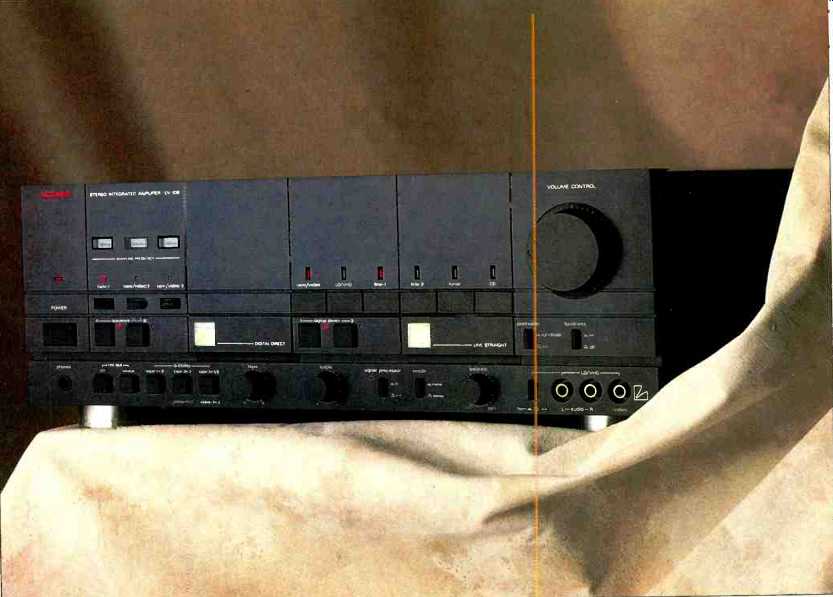
Manufacturer's Specifications:
Amplifier Section:
Rated Power Output: 150 watts per channel, 20 Hz to 20 kHz, both channels driven into 8-ohm loads.
Dynamic Power: 240 watts per channel into 8 ohms, 400 watts into 4 ohms, 600 watts into 2 ohms.
Rated THD: 0.03% (8-ohm loads).
S/N: 107 dB, A-weighted.
Frequency Response: 5 Hz to 200 kHz (-3 dB).
Input Sensitivity: 150 mV for rated output.
Tone-Control Range: Bass, ±9 dB at 100 Hz; treble. ±6.5 dB at 10 kHz.
Loudness-Control Action: +6 dB at 100 Hz; +4 dB at 10 kHz.
Digital-to-Analog Section
Input: 0.5 V peak-to-peak. 75 ohms (Sony/Philips format).
S/N: 96 dB. A-weighted (using 30-kHz low-pass filter).
THD: 0.005% at 1 kHz.
Dynamic Range: 94 dB. A-weighted (using 30-kHz low-pass filter).
Video Section Input: 1 V peak-to-peak, 75 ohms.
Output: 1 V peak-to-peak. 75 ohms.
General Specifications:
Power Requirements: 120 V. 60 Hz, 5.5 amperes.
Dimensions: 17 1/4 in. W x 6 1/2, in. H x 18 1/8 in. D (43.8 cm x 16.5 cm x 46 cm).
Weight: 44.9 lbs. (20.4 kg).
Price: $1,500.
Company Address: 19145 Gramercy Pl., Torrance, Cal. 90501, USA.
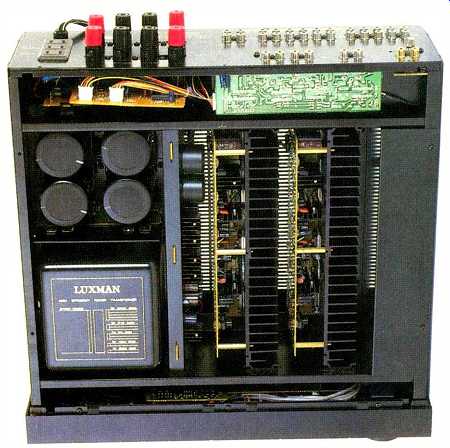
The first unusual thing you will notice about this elegant integrated amplifier from Luxman is the fact that it has no phono inputs. Does this mean that Luxman has written off the analog turntable and vinyl records? Not at all. It's simply that they have chosen to separate low-level preamplification and record equalization functions from high-level signal handling. A companion component, the Luxman LE-109 phono preamplifier, can be added, if desired, but for those who plan to listen only to Compact Discs, radio, tape (both analog and digital), and the audio tracks of video program sources, Luxman decided not to add the cost of a phono preamplifier circuit. Considering the number of new system buyers who seem to be bypassing analog turntable and cartridge purchases, this makes a great deal of sense.
Furthermore, the absence of a phono preamp section is offset by the incorporation of a D/A converter, in keeping with Luxman's "straight line" concept-specifically, that "the best audio reproduction is that which requires the least number of processing steps to transfer music from the source to the listener." By connecting the digital output of a CD player or DAT recorder to one of the LV-109's direct digital inputs, one can eliminate two analog signal-handling circuits (the CD player's analog output and the amplifier's analog input stages) from the audio signal path.
The LV-109 can accommodate virtually any system of audio and video components (though, as mentioned above, an external phono stage is needed for playing LP records).

A TV monitor can be directly connected as well, and an extra signal-processing loop is provided for such other components as a graphic or parametric equalizer. In addition to the usual rear-panel jacks, a set of front-panel jacks has been included for easy temporary connection of another audio/video component or of separate audio and video devices. According to Luxman, the video amplifier portion of the LV-109 is flat within-1 dB from d.c. to 6 MHz, with less than 1° differential phase and 1% differential gain.
Among the other unusual features incorporated in the LV 109 is direct dubbing capability for three audio tape decks and two video decks. If desired, all of the control and switching functions, except for volume control, can be completely bypassed, with the signal sent directly from the source input selectors to the power amplifier section.
Circuit Highlights
Luxman uses what they call Voltage Driven Amplification Circuitry in the design of the LV-109. By using selected FETs in critical circuits, only voltage, and not current, is required to drive the amplifier, thereby eliminating the loading effect inherent in bipolar circuitry. The first stage of the power amplifier section consists of a differential amplifier surrounded by a cascode "bootstrap" circuit, a current-mirror circuit, and a current-mirror constant-current circuit, thus achieving high gain, high speed, and low distortion.
The pre-driver stage is a cascode circuit using a MOS-FET of high transconductance (Gm) and having a constant-current load that makes it well suited to feed the driver stage. The power MOS-FETs used in the output stage are designed to handle up to 50 watts (with 8-ohm loads). Above that power level, signal handling is switched over to output transistors which have greater power-handling capacity.
The built-in D/A converter can handle digital input signals from such sources as a CD player with a digital output, a PCM processor, a DAT recorder, or even a broadcast-satellite tuner. Sampling frequencies of 32, 44.1, and 48 kHz are automatically recognized, and the circuit adjusts automatically for each of these frequencies. A single "clock" is used at the digital input for data demodulation and digital filtering. The digital filter is an 80th-order, linear-phase type with band ripple of only 0.09 dB, using two-times oversampling. Out-of-band attenuation is 90 dB or more at 24.8 kHz.
The analog filter used in conjunction with this circuit is a fifth-order Chebychev low-pass type.
This amplifier is constructed using a box-type chassis to provide the needed strength. Inside there are three compartments, each shielded from the others. The power-supply section is in the center compartment, with the D/A stage.
A second compartment houses the input sections and the third houses the control sections (tone controls, loudness circuit, etc.). The bottom plate and top cover have corrugated surfaces that help absorb external vibration, to keep such vibration from reaching sensitive internal components.
Protective circuitry incorporated in the LV-109 includes a power limiter with an appropriate time constant, a current limiter for protection against short circuits at the outputs, a thermal protector that monitors heat-sink temperatures, and a d.c. detection circuit.
Control Layout
The attractively designed black front panel of the LV-109 is divided into logically arranged sections, each of which is delineated by vertical grooves. The various selector switches take the form of squares or rectangles which are flush with the front surface. At the left are a "Power" button and its associated indicator light; below them is a stereo head phone jack. The next section to the right contains three indicators which tell the user the sampling rate of any direct-connected digital program source. Also in this panel section are buttons which select the speaker outputs, activate the three tape monitor loops, disable or activate the recording outputs, and offer three options for tape dubbing ("Tape 1-2," "Tape 2-3," and "Tape 3 1/2").
The next panel section has only a single, light-colored button, the "Digital Direct" selector, which is back-lit when depressed. The rotary "Bass" control is directly below this section; to the bass control's right is the "Treble" control, a button for selecting the extra signal processing loop, a mono/stereo "Mode" button, and a rotary balance control.
Above these, in the next two delineated sections, are but tons for selecting either of the two "Digital Direct" inputs, pushbuttons for selecting among the six available analog line-level inputs, and the back-lit "Line Straight" button, which is used to bypass tone controls and other line-level amplification stages for direct feed of any analog program source to the power amplifier. Along the lower right edge of the panel are three audio/video inputs that can be selected by means of a nearby "Front/Rear" pushbutton. Above these, in the rightmost delineated section, are a large master "Volume Control," an audio muting switch, and the "Loudness" switch. Luxman's familiar "L" trademark at the lower right corner of the panel, as well as all other nomenclature, is tastefully applied and clearly legible.
The rear panel carries the digital input jacks as well as the usual array of analog input jacks, color-coded binding posts for two sets of stereo speaker systems, and three convenience a.c. outlets (one switched, two unswitched). Notwithstanding the absence of phono inputs, a ground terminal normally associated with such inputs-is also available.
Two clear hookup diagrams are provided in the brief owner's manual, one for an audio component system, the other for audio/video components. Of course, a mix of both types of components is possible, providing the number of avail able tape monitor loops (three in all) is not exceeded.
Measurements
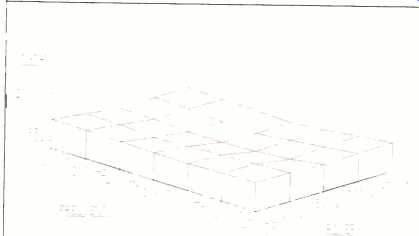
Fig. 1--Power output vs. THD + N and frequency for 8-ohm load.
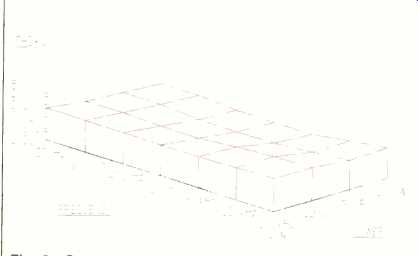
Fig. 2--Same as Fig. 1 but for 4-ohm load.
Connected to 8-ohm loads, the amplifier delivered 171 watts at 1 kHz before THD rose to its rated value of 0.03%.
At 20 Hz, maximum power output for that level of distortion was 156 watts per channel; at 20 kHz, the amplifier produced 159 watts of power per channel for the same THD level. At rated output (150 watts per channel, both channels driven), THD was only 0.003% at mid-frequencies, rising to 0.006% at 20 Hz and 0.027% at 20 kHz. Figure 1 shows how distortion varied as a function of power output and frequency with 8-ohm loads. SMPTE IM at rated output, again into 8 ohms, was an infinitesimally low 0.004%, and CCIF IM measured only 0.0026%. Damping factor, measured using a 50-Hz signal and an 8-ohm load, was just over 200.
When power output tests were repeated using 4-ohm loads, distortion rose a bit, though it was still so low as to be completely inaudible until overload levels were reached.
Specifically, at 240 watts per channel output, THD measured only 0.007% for a 1-kHz test signal. At the highest test frequency, however (20 kHz), THD rose, with readings of 0.04% at 100 watts output. At 20 Hz, the amplifier delivered 214 watts per channel for 0.03% distortion. Figure 2 shows the relationship of THD + N to frequency and power output levels for 4-ohm load operation.
When I first measured frequency response of the overall amplifier, I was somewhat surprised to find that the high-end cutoff points were nowhere near the frequencies specified by Luxman. While certainly adequate (the -1 dB point was at 26 kHz, the -3 dB point at 45 kHz), these cutoff points were a long way from the 200 kHz specified for -3 dB. I quickly discovered that to reach these wide-band results, the volume control had to be turned fully clockwise. In other words, the shunt capacitance from the volume control's movable arm to ground, when combined with the resistance between the volume control's arm and upper tap, formed an RC filter that caused a slight roll-off of high frequencies.
Since few users are likely to operate the amp at maximum volume, the claimed frequency response is a bit misleading.
However, when I did open up the control fully, the -3 dB point occurred at 200 kHz, exactly as specified.
Dynamic headroom with 8-ohm loads measured just over 1.7 dB. That means that for short-term power peaks, the amplifier can deliver as much as 240 watts per channel into 8-ohm loads or around 400 watts when driving 4-ohm loads!
Input sensitivity for all of the high-level inputs measured 12 mV for 1 watt output. For rated output, that would trans late to about 147 mV, very close to the 150 mV specified by Luxman. Signal-to-noise ratio with respect to 1 watt output, referenced to 0.5 V input, measured 80 dB, and S/N with the volume control fully counterclockwise measured 87 dB.
Figure 3 shows the maximum cut and boost range of the LV-109's bass and treble controls, and Fig. 4 shows the response characteristics of the loudness circuit at various volume levels from maximum to -50 dB. One can see that the degree of compensation in Luxman's loudness circuit is linked to specific settings of the volume control. Most loudness circuits are constructed this way, instead of having a separate, continuously variable compensation adjustment.
Without such a separate adjustment, it is impossible to attain proper loudness compensation for varying input pro gram levels-and today, these levels can vary more than ever, with CD players typically delivering 2.0 V of output while tuners and analog tape decks may deliver less than 1.0 V. Compensating for these differences by means of the volume control alone means that proper loudness compensation at low listening levels cannot possibly be achieved for all connected program sources, unless those program sources also have level controls.
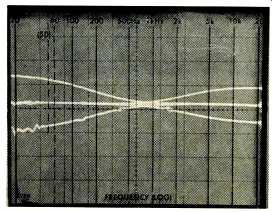
Fig. 3--Tone-control characteristics.
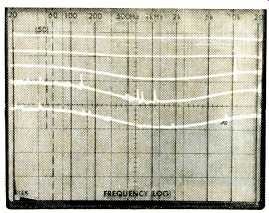
Fig. 4--Loudness compensation control characteristics at various volume
levels, from maximum to -50 dB.
Use and Listening Tests
The LV-109 provides many ways in which to listen to a wide variety of musical fare. I can report with reasonable assurance that the direct or "straight line" mode of listening did provide a very subtle degree of improvement in overall sound clarity and, particularly, in my ability to single out individual instruments in a large orchestral ensemble. Since my reference CD player has a digital output jack, I was eager to feed that output to a direct digital input on the LV 109. In order to make an instant A/B comparison, I also hooked up my player's analog outputs to a set of analog inputs on the LV-109. That way, I was able to quickly switch between analog and digital CD inputs just by pressing and releasing the amplifier's "Digital Direct" button. Try as I might, I could not hear any difference between the two modes. In a way, that speaks very well for the D/A converter circuitry in the Luxman unit, since my reference CD player has one of the most linear and accurate D/A converters that I have yet measured. I suspect that if I had had a lower cost, lower grade CD player with which to conduct this test, the results might have been different. On the other hand, low cost CD players do not have digital output jacks.
This much I can say: The digital input circuitry on the LV 109 instantly identified the sampling rate of the digital input and decoded it accordingly. Just to prove that it would work at alternate sampling rates, I hooked up my newly acquired reference DAT player. (Yes, contrary to some rumors, it's absolutely legal to import DAT players from abroad even while Congress debates whether or not they should require that anti-copy chips be incorporated in them!) Sure enough, when I connected the DAT player's digital output to the LV 109's digital input, and played back a recording that I had made on the DAT player, the indicator light instantly switched to 48 kHz (the sampling rate at which home recordings are made on DAT recorders), and clean, distortion-free audio filled my listening room. The quality of sound was indistinguishable from that of the CDs I had used to make the DAT recordings, despite the fact that the DAT recordings had been made from the analog outputs of the CD player. Discs which I used in this evaluation included a recently acquired London CD of Brahms' Symphony No. 1, performed by the Chicago Symphony Orchestra, and a recent Telarc release of Mozart's Symphonies Nos. 36 and 38, performed by the Prague Chamber Orchestra. A few other CDs were also used, to evaluate the reproduced quality of the human voice and that of a solo piano.
When Luxman products first appeared in this country in the mid-'70s, the company was perceived as being totally dedicated to state-of-the-art audiophile products. When management of the company was turned over to Alpine Electronics some years ago, it was feared that the product mix would be changed so as to appeal to a broader, more price-conscious audience. Indeed, for a couple of years that seemed to be the case. I am happy to report that Luxman has once again returned to the design philosophy that won them a pre-eminent reputation in their home market. With this flagship integrated amplifier, Luxman sound and quality are back where they belong-in a superb class by themselves.
-Leonard Feldman
(Source: Audio magazine, Sept. 1987)
Also see:
Luxman M-383 Amp and C-383 Preamp (Jan. 1995)
Luxman DX-103 Compact Disc Player (Nov. 1984)
Lux Audio MB-3045 Power Amplifier (Nov. 1977)
= = = =